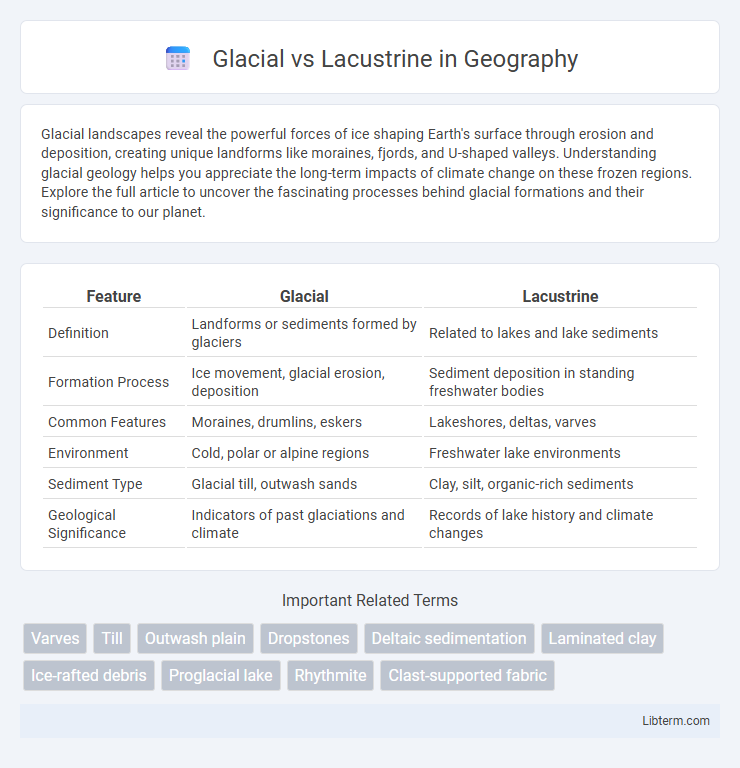Glacial landscapes reveal the powerful forces of ice shaping Earth's surface through erosion and deposition, creating unique landforms like moraines, fjords, and U-shaped valleys. Understanding glacial geology helps you appreciate the long-term impacts of climate change on these frozen regions. Explore the full article to uncover the fascinating processes behind glacial formations and their significance to our planet.
Table of Comparison
| Feature | Glacial | Lacustrine |
|---|---|---|
| Definition | Landforms or sediments formed by glaciers | Related to lakes and lake sediments |
| Formation Process | Ice movement, glacial erosion, deposition | Sediment deposition in standing freshwater bodies |
| Common Features | Moraines, drumlins, eskers | Lakeshores, deltas, varves |
| Environment | Cold, polar or alpine regions | Freshwater lake environments |
| Sediment Type | Glacial till, outwash sands | Clay, silt, organic-rich sediments |
| Geological Significance | Indicators of past glaciations and climate | Records of lake history and climate changes |
Introduction to Glacial and Lacustrine Environments
Glacial environments are characterized by the presence of ice masses that shape landscapes through processes like erosion, transport, and deposition of sediments, resulting in distinctive features such as moraines and drumlins. Lacustrine environments, on the other hand, pertain to lakes, where sedimentation occurs in relatively calm water, producing finely layered deposits rich in organic material and fossils. Understanding the interplay between glacial activity and lacustrine sedimentation helps reconstruct past climatic conditions and paleoenvironmental changes.
Formation Processes: Glacial vs Lacustrine Systems
Glacial systems form through the accumulation and movement of ice, which carve out valleys and deposit moraines, creating features like fjords and glacial lakes. Lacustrine systems develop within depressions or basins, primarily driven by sedimentation from rivers, precipitation, and groundwater inflow, resulting in stratified sediment layers. The key difference lies in glacial systems being shaped by ice dynamics and erosion, whereas lacustrine systems are predominantly influenced by sedimentary and hydrological processes.
Key Geological Features of Glacial Deposits
Glacial deposits are characterized by unsorted sediments known as till, which include a mixture of clay, sand, gravel, and boulders directly deposited by ice movement. These deposits often form landforms such as moraines, drumlins, and eskers, reflecting the dynamic processes of glacier advancement and retreat. The presence of striations and polished bedrock surfaces further distinguishes glacial deposits from lacustrine sediments, which are more sorted and fine-grained due to calm water deposition in lake environments.
Typical Characteristics of Lacustrine Sediments
Lacustrine sediments typically exhibit fine-grained textures such as silts and clays, reflecting deposition in calm, low-energy lake environments. These sediments often display well-defined lamination and can contain organic-rich layers, indicating periods of anoxic conditions and high biological productivity. Fossils of freshwater organisms and distinct mineral compositions like calcite or gypsum are common, helping to differentiate lacustrine deposits from coarser, more heterogeneous glacial sediments.
Morphological Differences in Depositional Structures
Glacial depositional structures typically exhibit irregular, unsorted sediments such as till, characterized by large clasts embedded in a finer matrix, resulting from direct ice contact and melting processes. Lacustrine deposits, in contrast, show well-sorted, fine-grained sediments like silts and clays, forming distinct horizontal laminations and varves due to seasonal sedimentation in standing water bodies. These morphological differences in texture, sorting, and layering patterns are key indicators for distinguishing between glacial and lacustrine depositional environments.
Climate Influence on Glacial and Lacustrine Development
Glacial and lacustrine environments are profoundly shaped by climate, where cooler temperatures favor glacier formation and advance, while warmer climates promote lake development through melting ice and increased precipitation. Glaciers sculpt landscapes via ice accumulation and ablation cycles, significantly influenced by temperature and snowfall patterns over time. Lacustrine systems respond to climatic variations by altering water volume, sedimentation rates, and nutrient input, reflecting changes in precipitation and evaporation dynamics.
Sediment Transport and Deposition Mechanisms
Glacial sediment transport involves the movement of unsorted debris by ice through processes like plucking and abrasion, resulting in till deposits with varied grain sizes. Lacustrine sedimentation occurs as fine particles settle from suspension in still or slow-moving lake waters, forming well-sorted, stratified layers of silts and clays. Differences in energy regimes between glaciers and lakes drive distinct deposition patterns, with glaciers depositing heterogeneous, angular sediments and lacustrine environments favoring uniform, layered sediment accumulation.
Paleoenvironments: Reconstructing Past Glacial and Lacustrine Settings
Glacial environments are characterized by the presence of ice masses that shape landscapes through processes like erosion and deposition, forming features such as moraines and drumlins. Lacustrine settings pertain to lake systems where sedimentation occurs in relatively calm water, preserving fine-grained deposits like varves that record seasonal and climatic variations. Reconstructing past glacial and lacustrine environments involves analyzing sedimentary structures, isotopic compositions, and fossil assemblages to interpret paleoclimate conditions and the dynamics of ice-sheet fluctuations.
Environmental and Ecological Implications
Glacial environments, characterized by ice masses and cold temperatures, significantly influence freshwater ecosystems through nutrient-poor meltwater and sediment transport shaping downstream habitats. Lacustrine systems, found in lake environments, support diverse aquatic species with nutrient cycling and sediment accumulation that foster complex food webs and carbon sequestration. Both ecosystems play crucial roles in regulating regional hydrology and carbon budgets, impacting biodiversity and climate resilience.
Summary: Comparing Glacial and Lacustrine Geology
Glacial geology studies landforms and sediments shaped by glaciers, characterized by features like moraines, eskers, and drumlins formed through ice movement and melting. Lacustrine geology focuses on lake environments, analyzing sediment layers deposited in standing water that reveal climate variations, biological activity, and sedimentation processes. Comparing both highlights glacial deposits as typically coarse and heterogeneous, while lacustrine sediments are finer, stratified, and often rich in organic material, providing distinct paleoenvironmental records.
Glacial Infographic

 libterm.com
libterm.com